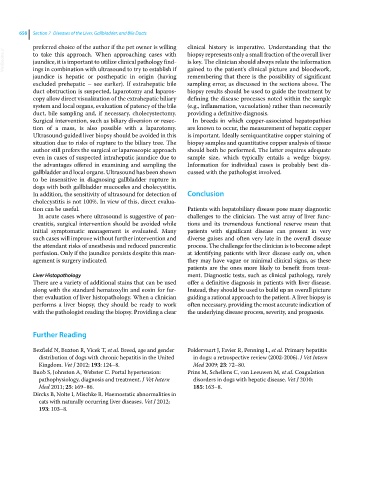Page 690 - Clinical Small Animal Internal Medicine
P. 690
658 Section 7 Diseases of the Liver, Gallbladder, and Bile Ducts
preferred choice of the author if the pet owner is willing clinical history is imperative. Understanding that the
VetBooks.ir to take this approach. When approaching cases with biopsy represents only a small fraction of the overall liver
is key. The clinician should always relate the information
jaundice, it is important to utilize clinical pathology find-
ings in combination with ultrasound to try to establish if
remembering that there is the possibility of significant
jaundice is hepatic or posthepatic in origin (having gained to the patient’s clinical picture and bloodwork,
excluded prehepatic – see earlier). If extrahepatic bile sampling error, as discussed in the sections above. The
duct obstruction is suspected, laparotomy and laparos- biopsy results should be used to guide the treatment by
copy allow direct visualization of the extrahepatic biliary defining the disease processes noted within the sample
system and local organs, evaluation of patency of the bile (e.g., inflammation, vacuolation) rather than necessarily
duct, bile sampling and, if necessary, cholecystectomy. providing a definitive diagnosis.
Surgical intervention, such as biliary diversion or resec- In breeds in which copper‐associated hepatopathies
tion of a mass, is also possible with a laparotomy. are known to occur, the measurement of hepatic copper
Ultrasound‐guided liver biopsy should be avoided in this is important. Ideally semiquantitative copper staining of
situation due to risks of rupture to the biliary tree. The biopsy samples and quantitative copper analysis of tissue
author still prefers the surgical or laparoscopic approach should both be performed. The latter requires adequate
even in cases of suspected intrahepatic jaundice due to sample size, which typically entails a wedge biopsy.
the advantages offered in examining and sampling the Information for individual cases is probably best dis-
gallbladder and local organs. Ultrasound has been shown cussed with the pathologist involved.
to be insensitive in diagnosing gallbladder rupture in
dogs with both gallbladder mucoceles and cholecystitis.
In addition, the sensitivity of ultrasound for detection of Conclusion
cholecystitis is not 100%. In view of this, direct evalua-
tion can be useful. Patients with hepatobiliary disease pose many diagnostic
In acute cases where ultrasound is suggestive of pan- challenges to the clinician. The vast array of liver func-
creatitis, surgical intervention should be avoided while tions and its tremendous functional reserve mean that
initial symptomatic management is evaluated. Many patients with significant disease can present in very
such cases will improve without further intervention and diverse guises and often very late in the overall disease
the attendant risks of anesthesia and reduced pancreatic process. The challenge for the clinician is to become adept
perfusion. Only if the jaundice persists despite this man- at identifying patients with liver disease early on, when
agement is surgery indicated. they may have vague or minimal clinical signs, as these
patients are the ones more likely to benefit from treat-
Liver Histopathology ment. Diagnostic tests, such as clinical pathology, rarely
There are a variety of additional stains that can be used offer a definitive diagnosis in patients with liver disease.
along with the standard hematoxylin and eosin for fur- Instead, they should be used to build up an overall picture
ther evaluation of liver histopathology. When a clinician guiding a rational approach to the patient. A liver biopsy is
performs a liver biopsy, they should be ready to work often necessary, providing the most accurate indication of
with the pathologist reading the biopsy. Providing a clear the underlying disease process, severity, and prognosis.
Further Reading
Bexfield N, Buxton R, Vicek T, et al. Breed, age and gender Poldervaart J, Favier R, Penning L, et al. Primary hepatitis
distribution of dogs with chronic hepatitis in the United in dogs: a retrospective review (2002‐2006). J Vet Intern
Kingdom. Vet J 2012; 193: 124–8. Med 2009; 23: 72–80.
Buob S, Johnston A, Webster C. Portal hypertension: Prins M, Schellens C, van Leeuwen M, et al. Coagulation
pathophysiology, diagnosis and treatment. J Vet Intern disorders in dogs with hepatic disease. Vet J 2010;
Med 2011; 25: 169–86. 185: 163–8.
Dircks B, Nolte I, Mischke R. Haemostatic abnormalities in
cats with naturally occurring liver diseases. Vet J 2012;
193: 103–8.

